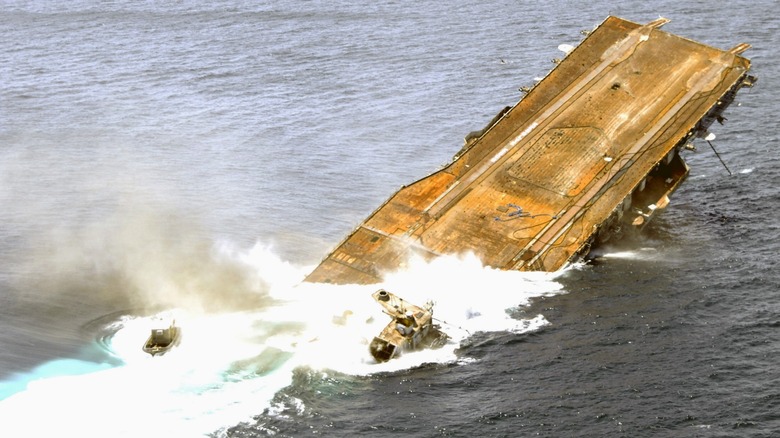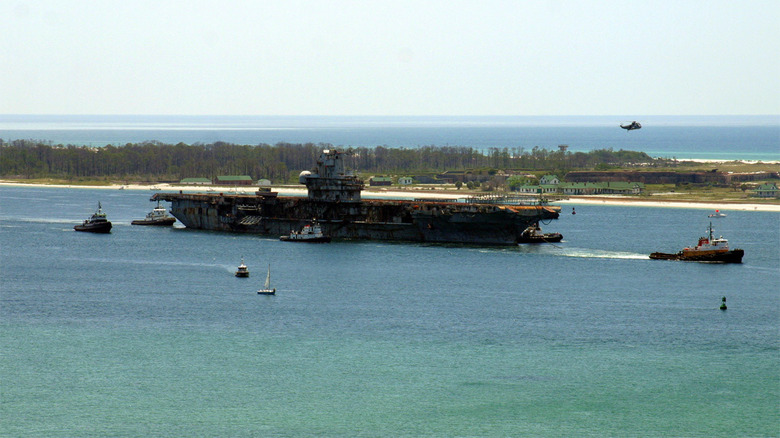Why Did The Navy Sink Aircraft Carrier CV/CVA-34 (USS Oriskany) & Where Is It Now?
USS Oriskany (CVA-34), named after the 1777 Battle of Oriskany, was an Essex-class aircraft carrier that stood 872-feet long with a beam of 147.5 feet. The US Navy commissioned her in 1950 and designated the carrier CV-34. However, in a Navy-wide effort to distinguish the difference between anti-submarine carriers (CVS) and others, the Navy reclassified the Oriskany as an attack carrier (CVA) in 1952. She earned herself two battle stars for her service during the Korean War and 10 for the Vietnam War. She was decommissioned once in 1957 while she underwent a significant overhaul, including a new flight deck. She was recommissioned in 1959 where she served until retirement in June 1976.
Every naval vessel enjoys a different retirement. Some become floating museums, others are scrapped, but the Oriskany was sunk. American carriers are particularly tough to sink and the last one to sink at war was in 1945. So it comes as no surprise to hear that the USS Oriskany was intentionally sunk. Furthermore, she was the first naval warship to be intentionally sunk and has served as the largest artificial reef. Japan was initially interested in buying the carrier to turn it into a floating museum, but they decided against it. The Navy tried scrapping her but there were environmental concerns.
The Navy spent years cleaning and removing all hazardous materials from the Oriskany. By the time that was done, the it worked with Florida Fish and Wildlife Conservation Commission (FWC), and Escambia County in Florida to sink the carrier.
[Featured image by U.S. Navy via Wikimedia Commons | Cropped and scaled | Public Domain]
Where in the world is the USS Oriskany (CV/CVA-34)?
The USS Oriskany's (CV/CVA-34) final resting place is roughly 22 nautical miles off of Florida's coast southeast of Pensacola Pass. The US Navy had to coordinate with the FWC and Escambia County, where Pensacola is located, to find the best place to sink the carrier. It's a popular attraction for touring divers and likely an impressive sight. However, since it sits 212 feet below the water's surface and currents in the area can get forceful, it's advised that nobody dive to the shipwreck unless they're properly trained, have experience, and have the appropriate equipment.
Storms and currents are constantly changing the conditions of the Oriskany. The depth of the artificial reef has even changed over time. Since the carrier isn't exactly structurally sound, having been submerged since 2006, FWC strongly cautions divers against attempting to venture inside. Artificial reefs serve several purposes such as improving habitats for ocean life that will increase populations of fish and other marine life.
Oriskany is in good company in the Gulf Coast. The battleship USS Massachusetts is only 1.5 nautical miles south-southwest of Pensacola Pass in roughly 30 feet of water. And then 21 nautical miles east of Pensacola Pass is an old freighter called the Antares that rests 130 feet deep. It's easy to think of these resting places as graveyards for large metal behemoths, but they also now serve as homes for groupers, nurse sharks, stingrays, and sea turtles.
[Featured image by U.S. Navy Photo by Mike O'Connor via Wikimedia Commons | Cropped and scaled | Public Domain]

